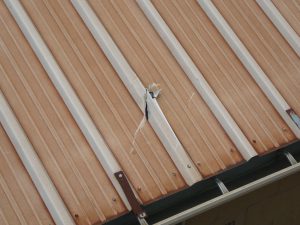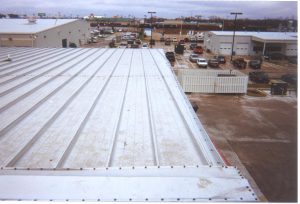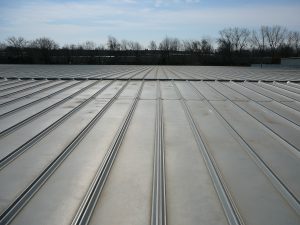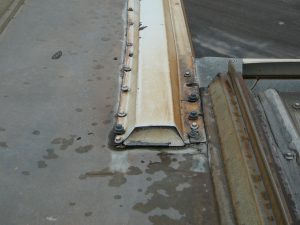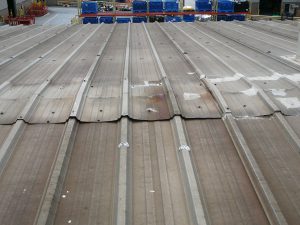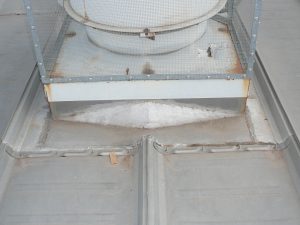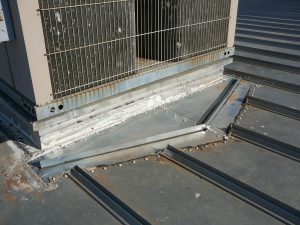Part I of II
by Ray Heisey, P.E., RRC, LEED AP
When you inspect or reinspect a metal roof or investigate a roof leak to determine the source and potential solution, where do you start?
Typically, 95 percent or more of a metal roof isn’t a potential source of leaks or problems. A metal roof typically has at least 1/4″ per foot or more slope to the gutter or roof edge. The steel or aluminum panels are solid sheets, impervious to moisture, vapor or air transmission. The panels are virtually puncture proof and, if damage has occurred, it is typically obvious during a visual metal roof inspection.
An obvious gash/cut through an exposed fastener, ribbed steel roof panel.
The individual roof panel sheets are joined together at side laps that are raised above the plane of water flow. An exposed fastener ribbed roof uses sealant and exposed fasteners at the side lap and end lap joints. A standing seam roof uses a formed sheet metal joint with factory-applied sealant at the side lap joints, and sealant and exposed fasteners at the end lap joints.
When doing a visual check of the roof system, some potential problem areas should be investigated first. There are roof system design and installation-related issues that can make repairs, temporary at best, or worst case, a waste of money. These issues include:
- Misalignment of roof panels (out of module installation)
- In-line panel end lap splice joints (non-staggered end laps)
- Poorly designed roof trims and flashings that do not accommodate movement
Panel installation ‘creep’ as they progress down the roof. Panel ribs should be parallel to the end of the building.
One manufacturer supplies pre-punched secondary structural members to ensure proper panel alignment during installation. All other manufacturers rely on the skill of the installer to keep panels aligned during installation. Roof panel ribs that are not parallel to adjacent panel ribs will restrict expansion and contraction movement. Metal roof panels move in all directions. Movement across the width of the panels is accommodated by the flat of the panel bowing up and down, or by the shape of the roof panel rib flexing or deforming. A trapezoidal shaped roof panel rib can act as a ‘bellows’, easily accommodating expansion and contraction movement. Roof panels are very stiff in the direction of the panel ribs which is why standing seam roofs use movable roof clips (in the panel rib).
Out-of-module installation showing direction change at panel splice joints.
Misalignment of panels most commonly occurs at an in-line panel end lap splice joint. Looking at the panel ribs, they change direction at the panel end lap splice joint. Where the panel rib changes direction, expansion and contraction movement cannot move through the misaligned panel rib joint the stresses are concentrated. This can result in the roof panels on upper and lower sides of the end lap splice joint working against each other. The concentrated stresses at the end lap can cause movement in the end lap joint which is not desirable, slotting of the panels around end lap fasteners and backing out of threaded end lap fasteners.
Almost every standing seam roof utilizes concealed roof clips that are supposed to allow roof panels to expand and contract differentially from the building structure to which the roof clips are attached. Where roof panels terminate at walls, expansion and contraction movement of the panels must also be accommodated by the trim or flashing at the roof edge.
Unfortunately, many times a trim or flashing is not designed to move. If the trim or flashing is secured to the roof panels with numerous stitch screw fasteners, you may surmise that the trim or flashing will have limited or no ability to accommodate expansion and contraction movement in a like manner as the roof panel clips.
Open upslope end of rake/gable flashing.
Slotting around fasteners and backed out threaded fasteners indicate that the trim or flashing is not allowing the expansion and contraction movement to occur in a controlled, designed-for manner. Design and/or installation defects that restrict roof movement cannot be easily corrected and may be costly to address. The only prudent course of action may be to perform temporary repairs in anticipation of a near term roof replacement or recover.
If the roof was installed with minimal design and/or installation defects, then a more detailed investigation may provide the information required to assist with the decision to proceed with roof repairs or roof replacement.
Investigative tools to diagnose leak issues on a metal roof are:
- Visual – look for problem areas such as gaps between roof panels and fasteners not seated.
- Check – Penetrations and flashings for potential issues
- Probe – Using a wire probe (paper clip size) to ascertain whether there is contiguous sealant in joints
- Test (Wallace Seal Tester) – Check fasteners for air leakage
- Investigate – Disassemble joints to check sealant integrity and evidence of water infiltration
Large gaps in metal panel end lap joints are an obvious place to check.
The predominant manufacturer- supplied joint sealant used in metal panel roofs is a butyl rubber based sealant. Butyl rubber sealant is supplied in a tube (pumpable) or as a tape (semi-solid in a roll). Butyl rubber sealant is not UV stabilized and must be retained in the sheet metal joint and protected from UV light. Typical sheet metal joints are designed so that a small amount of butyl sealant squeezes out of the joint to prevent water wicking between the two metal surfaces. Butyl sealant exposed to sunlight will dry and crack in less than a year.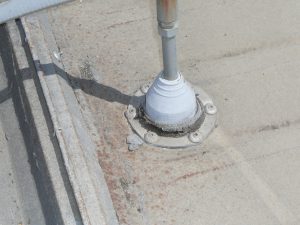
Crack opening in molded flexible pipe flashing.
The molded, flexible EPDM pipe flashing looks fine at first glance. However, a more detailed inspection shows that the flashing has an open horizontal crack behind the aluminum reinforcing ring. Flexible pipe flashings should be manually pushed on to reveal any cracks or other defects. With a push near the top of the flashing it can be determined whether accumulated snow or ice will create a gap when pushed against the flexible flashing.
A stainless steel hose clamp should always be used to secure flexible pipe flashing to a pipe penetration. The best performing pipe flashings are made from black EPDM for normal temperature applications and from silicone for high temperature applications. Gray EPDM pipe flashings do not have the same longevity and performance as black EPDM pipe flashings. EPDM derives its UV resistance from the carbon black in the formulation and black EPDM has higher carbon black content than gray EPDM.
Many curbed penetrations on metal roofs utilize an over-abundance of exposed fasteners. Exposed fasteners can be visually checked and tested as a potential source of leaks. The joint between the curb and the roof panels should be checked with a wire probe for evidence of sufficient waterproofing butyl sealant.
A 28-year-old, fabricated metal curb installed on a standing seam metal roof. The curb looks to be in very good condition and functioning as intended. No previous repair attempts are noted.
A 19-year-old, fabricated metal curb installed on a standing seam metal roof. Numerous caulking repairs are evident and stitch screws look to be installed approximately 6 inches on center.
A wire probe can be fashioned from a straightened paper clip (normal and large size paper clips, depending on the joint size). The wire probe is inserted into the joint checking for resistance. When withdrawn, the probe is checked for sealant residue. Butyl sealant residue should leave some tackiness on the withdrawn probe. Wipe the probe with a rag to remove any sealant residue, as multiple locations along a joint should be checked. The application of joint sealant must be contiguous across the entire joint. Any gaps in a sealant joint can be a potential source of leaks, especially with wind-blown rain or any negative pressure created by the building HVAC or ventilation system. A flat ‘feeler gauge’ type probe is not recommended as it can displace the existing sealant when used.
Learn more in Metal Roof Inspections Part II.

